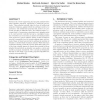112 search results - page 21 / 23 » Securely Obfuscating Re-encryption |
CCS
2009
ACM
14 years 3 months ago
2009
ACM
Along with the burst of open source projects, software theft (or plagiarism) has become a very serious threat to the healthiness of software industry. Software birthmark, which re...
CTRSA
2009
Springer
14 years 3 months ago
2009
Springer
Proxy re-encryption (PRE) allows a proxy to convert a ciphertext encrypted under one key into an encryption of the same message under another key. The main idea is to place as lit...
DRM
2005
Springer
14 years 2 months ago
2005
Springer
Advances in reverse engineering and program analyses have made software extremely vulnerable to malicious host attacks. These attacks typically take the form of intellectual prope...
CCS
2007
ACM
14 years 16 days ago
2007
ACM
Remotely-launched software exploits are a common way for attackers to intrude into vulnerable computer systems. As detection techniques improve, remote exploitation techniques are...
SP
2010
IEEE
14 years 13 days ago
2010
IEEE
—To handle the growing flood of malware, security vendors and analysts rely on tools that automatically identify and analyze malicious code. Current systems for automated malwar...

